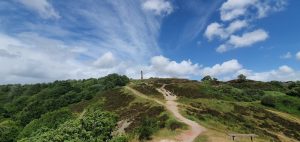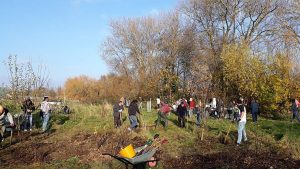Any tree will need judicious trimming from time to time, either in the interests of safety or to lessen shade cast underneath them. Some jobs require a specialist but some can, with care, be undertaken by the group.
Branch Removal
Basic method is with three cuts. First (A) is done underneath to stop any unnecessary damage to the tree when the branch comes off. The second (B) is made on top, 1″ away from A and is the main cut and the third cut (C) is the final cut removing the branch. Leave a good join to the base of tree. The stump can be treated but recent research shows it doesn’t do much good.
Cleaning out
This is the removal of dead and diseased branches, hanging branches which are still attached, old stumps, ivy and general rubbish. This lets a tremendous amount of light onto ground below tree.
Crown lifting
This involves taking off lower branches to ease access beneath for traffic, etc.
Frithing
The frith is all the secondary shoots growing along the trunk and branches of some trees especially oak and lime. Removing these allows in more light.
Bark Wounds
Use a chisel for this. If the area of bark is dying off after having been banged or otherwise damaged, first check extent of damage – dead bark will come away easily. Then, using chisel, extend the area to an elipse and remove all bark within this area. The area must have a clean edge to encourage tree to form a callous on the edge.
Cavities
If you find an area full of soft gooey matter, clean it all out to see how much damage there is. Trees often manage to compartmentalise decay to a small area. If area is extensive, seek advice of County or Local Council Forestry or Arboricultural Officer.
Felling a Tree
Simple if you know how, dangerous if you don’t.
Before felling, even if there is no legal restriction, bear in mind the difference the loss of that tree will make to the landscape and environment.
Cut trees if they are growing too close – trees need space to grow well; if branches hang too low or are causing shade in difficult places. However if tree has died or begun to decay and become dangerous, it should be felled. Assess which way tree leans.
Method of felling
A tree is felled with three cuts. Chop a large wedge in the tree (cuts A and B) on side you want it to fall. Make third cut (C) 1″ above (B) on other side of tree. Between Cut C and the back of the wedge is an uncut area called the hinge. If tree hasn’t fallen by the time the hinge is 2″ thick, remove saw and put out of the way and drive wedges into C to lever it over. When it starts to fall, move well clear in case it bounces when it lands.
This is the process for a perfectly erect tree with nothing to obstruct its fall.
If you wish it to fall against the way it leans you will need to use a sledge hammer and steel felling wedges to lever it over or a rope tied high in the crown. You will need helpers to pull the tree over or a tractor and steel cable. Clear away rubbish from base of tree and make sure you have a clear escape route in case of mistakes.
Best to get professional help if it is very large, leaning heavily, close to a ditch, telegraph pole, etc., or growing on uneven ground.
After Felling
The removal of branches from the trunk of a felled tree is called ‘snedding’ and can be more dangerous than felling, especially if trunk is held off ground by branches.
Start at base and work to crown, standing on the left of the tree. Remove each branch with a flush cut. Remove large branches in several sections. Before cutting assess strain on branch and cut accordingly to avoid getting saw jammed.
Remove branches out of your way as you work so as to give you room for a quick escape if it drops or rolls, because sooner or later you will cut the branch supporting the tree.
Cross cutting
Felled trees can either be sold to timber merchant or used in park. Decide how best to make use of them. Thin straight lengths make fencing stakes, 5’6″ and pointed for fencing, corner post strainers, (8′) and round fencing rails. Thicker straight lengths are fencing corner posts (7’6″) and gate posts 7’6″. Bigger timber cut into manageable planks as saw rails or stakes. Cut tree for a specific purpose. Any post too bent to use become fire logs.
Planking
Lay a couple of stakes on ground and roll length of planking timber onto these to hold it clear of the ground.
You can do a rough job with a chain saw but a chain saw is designed to cut across grain not with the grain, so it will struggle. Cut log to square section by four cuts to remove bark, then mark off thickness of required planks and work from one end of log to other to remove each plank. Finished plank will be a little rough but sufficient for most jobs. A more professional job is done with a small portable saw mill. (Abbey Chain saws produce one).
Safety
- Never use chainsaws without official training, they are extremely dangerous. Failing attending a course, stick to an axe and hand saw.
- Don’t use chainsaws or climb trees out of earshot of someone else.
- Don’t use chainsaw except when standing firmly on ground.
- Don’t cut branches while standing on a ladder – it’s safer to stand in tree – but don’t cut between yourself and the tree trunk, or you will fall with the branch!!
- Don’t cut near power cables.
- By law you need warning signs if working by a road – at least someone to stop cars while you drop a branch, even if you don’t expect it to fall on the road.
- If you’ve never used a chainsaw go on a course set up by local Agricultural College or Forestry Commission or NCTV.
- Wear protective clothing and helmet and goggles at all times.
Additional Safety note
Never use trees as fence posts, because a nail buried in the wood can cause appalling accidents when a chain saw is used on the tree.
Splitting logs
Cart wood to one particular area to cut into logs as this keeps the mess down.
To cut wood properly, a sawhorse is needed. If it is left in place the floor below can be marked with sizes to make cutting quicker. Put it on a smooth surface so sawdust can be gathered for litter or as a mulch. Chippings and twigs can be stored in bags for starting fires.
Drive wedge into end of log with sledgehammer. Drive wedge in carefully so as not to splinter wood. Continue driving wedges down log until it splits in half. Once split it can be chopped into smaller pieces.
Bonfires
Site needs careful choosing. Needs to be sheltered but not windless as a breeze helps it burn quickly, while gale blows it out, makes it burn too quickly or makes it dangerous. Overhangs will get burnt in a clearing. Bonfires sterilise soil underneath and potash left can be stored or spread immediately.
To start bonfire
Use needle thin birch twigs, snapped from tree rather than off ground. Once lit, add finger thick pieces then add thicker wood but of even lengths and all lying in direction of breeze.
Even hot embers can burn when stamping out, so take care.
Additional Goodies from trees
Elderberry – discourages flies, so often planted near larder of house or near kitchen window and door. Elder blossom makes tea and wine as well as champagne. The berries also make wine.
Hazel – apart from the nuts, gives bean sticks and pea boughs.
Holly – male and female needed to get berries.
Mistletoe – If you make a slit in an apple tree branch or oak and rub several mistletoe berries over it, it may seed and grow. Berries will usually only grow on species of tree they were collected from.
Mountain Ash (rowan) – berries make good jelly for eating with game.
Wild crab apple – makes jelly which is delicious and helps when making wines and jams.
Quince – smells heavenly and the fruits makes delicious preserves.
Medlars – eaten when they look rotten or made into jelly.
Lime – favourite with bees. Makes herbal tea and fills garden with honeyed scent.
Walnut – walnut trees are not very common now, if you own one, prize it for its fruit.
Animal Damage
Once established trees don’t suffer from animals with the exception of goats and wild animals like deer, rabbits and squirrels. Goats will eat the bark. A few horses will also, but it is rare. If this does happen get Treebark Protector from the Country Gentleman’s Association and paint it on. The foul smell discourages them.
Young trees are a different matter and if planted in a grazing area will need protection of tree guards (CGA) or a stout fence.
Animals may nibble lower branches but this alters shape rather than damages.
Replanting
Plant at least two trees for every one you fell. Hardwood likely to take 20 years before it is ready to fell, while ash is ready in 12 years.
Dutch Elm Disease
The strain Sapporo Autumn Gold of elm is resistant to Dutch Elm Disease.
Leaf litter
Rake leaves into piles preferably against traps and then stuff paper feed bags with dry leaves, especially beech and oak. Evergreens no use as they aren’t absorbent. Store the leaves and sell bags as poultry litter or use when paths have become muddy.
Can also be used to mulch raspberries and gooseberries at right time. Looks better than black polythene.
Can also be used on a special long-term compost heap. They take about two years to break down but are an essential part of good potting compost.
Forestry Grants
The Forestry Commission (Oct 1986) introduced 2 grant schemes. The Forestry Grant Scheme in 1981 and the Broadleaved Deciduous Grant Scheme in 1985 to encourage planting of trees.
Forestry Grant Scheme
Available in respect of individual areas over 0.25 hectares. Timber production must be main objective. Broadleaf attracts higher grant.
Eighty per cent is payable on planting and twenty per cent 5 years later provided properly maintained.
Broadleaved Woodland Grant Scheme
Designed to encourage rehabilitation of existing broadleaved woodland by natural regeneration of planting and the establishment of new woodlands. Offers higher rates than the Forestry Grant Scheme for planting or natural regeneration of broadleaves alone. If you prefer a mixture you must use the FGS.
Other Grants Available
Countryside Commission or Local Authority may help with areas less than 0.25 ha.
Licencing of tree felling
Under Forestry Act 1967 you may need licence to fell a tree. A licence must be in existence before tree is felled and responsibility is on person who fells tree, whether the owner or not.
When is licence not required
If any of the following apply, a licence not needed
- Felling in accordance with approved Forestry Commission Plan of Operations under FC Grant Scheme.
- Trees in garden, orchard, churchyard or public open place.
- Trees below 8 cm in diameter at 13 m from ground. In case of coppice or underwood, below 15 cm diameter.
- Trees interfering with permitted development or statutory works by public bodies.
- Trees dead, dangerous, causing a nuisance or badly affected by Dutch Elm disease.
- Felling in compliance with Act of Parliament.
Trees can be lopped or topped and hedges trimmed or layered without a licence.
If in doubt ask Forestry Commission before felling.
Applying for licence
Owner of land where trees growing, tenant whose lease entitles him to cut trees or by the agent of either, can apply for licence. Timber merchant can’t, unless one of the above applies to him. He must ensure valid licence exists before felling or he risks prosecution.
Applications made on Form PW11 obtained from Forestry Commission. Apply in plenty of time because Forestry Commission sometimes have to consult with other authorities, ie Local Authority, Nature Conservancy, Countryside Commission, etc. If trees are in SSSI (Site of Special Scientific Interest) owner must clear works with Nature Conservancy Council before licence application can be accepted.
Generally Forestry Commission will inspect and may require replanting in specified time after felling.
You have a right of appeal if you feel you have been refused a licence unreasonably.
Licence for set period usually two years. If you have not felled any or all when licence expires you must apply for renewal.
Illegal Felling
You risk a set fine or twice value of trees whichever is higher and may have to replant.
Tree Preservation Order
If Local Authority Tree Preservation Order on trees or woodland area, this protects tree from wilful damage, destruction, felling, lopping or uprooting without Local Authority consent.
If you wish to fell a tree covered by TPO which would not normally require licence, apply to Local Authority. Otherwise apply to Forestry Commission as normal.

Reproduced with permission of North West Parks Friends Forum







